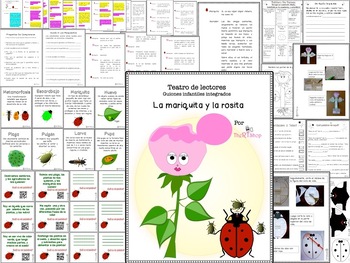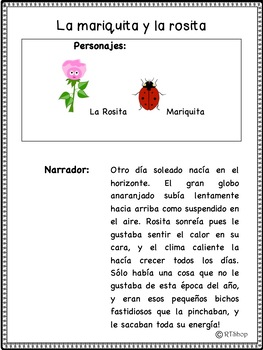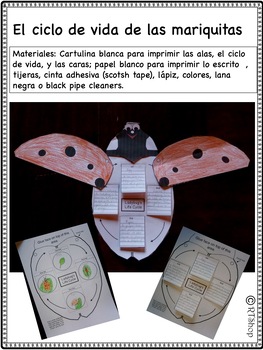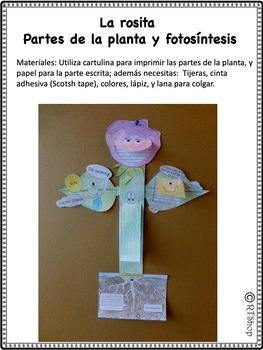Spanish Reader's Theater Script: Life Cycles, Insects And Plants, Photosynthesis
- PDF
Description
Science and Reading Integration: "La mariquita y la rosita"
Interacciones entre plantas e insectos, ciclos de vida, fotosíntesis, partes de la planta, metamorfosis, necesidades básicas
Guiones infantiles integrados
This Reader’s Theater Package is a great resource to use in your classroom in many ways: Reading, Writing and/or Science Centers, small group activities, partner’s activities, or teacher table.
This script will make reference to:
Interactions between ladybugs and plants.
Basic Needs
Life Cycles Of Plants And Ladybugs
Parts Of A Plant
Photosynthesis
Metamorphosis
The Package Includes:
Cover
Introduction
Reading, Listening, Speaking, Science Standards
16pg. B&W Script
16pg. Highlighted Parts Script
Comprehension Questions
Complete Sentence Answering Sentence Stems
20 Vocabulary Cards
20 QR Codes Self Test Cards
20 “I AM, Who IS?” Game Cards
Name The Parts Of A Plant Coloring-Naming Activity
True Or False Assessment Activity
Fill In The Blank Assessment Activity
Writing Prompt “An Impossible Dream”
Homework Board Page
My Ladybug Observation Page
Ladybug’s Life Cycle Craft FUN!
Little Rose’s Parts Craft FUN!
Plan Your Own Script Template
Script Template
Reader’s Theater is one of the best tools in the classroom to have students gain fluency, accuracy and comprehension in reading. It also reinforces listening skills, and teamwork.
This is a fun little script, in which the students will learn a lot about plants and insects, while learning new Science vocabulary and getting their reading fluency practice!
It includes two great very visual crafts activities, where you can assess your student’s learning and exhibit their work!
It has a planning sheet, and a template for your students to write their own script. In my experience students love this activity, and they get to use their own voice in the creation.
Make sure they act out the script provided, and later on, they can act out their own script, with their own characters.
I’m a bilingual teacher so all my plays will be written in English and Spanish, but you can buy them separately in my store. The script will come both highlighted for color copies, or B&W for saving ink.
Hope you and your critters enjoy a little drama! ☺
This package includes lots of reading activities that are part of the Reading Standards for 2nd, 3rd, 4th, and 5th grade.
Reading Literature:
CCSS.ELA-LITERACY RL 21,3.1,4.1,5.1
CCSS.ELA-LITERACY RL 2.3,3.3,5.3
CCSS.ELA-LITERACY RL 3.4,4.4
CCSS.ELA-LITERACY RL 3.5,4.5,5.5
CCSS.ELA-LITERACY RL 3.10,4.10,5.1
Reading Foundational Skills:
CCSS.ELA-LITERACY RF 2.4,3.4,4.4,5.4
Speaking And Listening:
CCSS.ELA-LITERACY SL 21,3.1,4.1,5.1
Science Common Core Standards 2nd, 3rd, 4th
(9) Organisms and environments. The student knows that living organisms have basic needs that must be met for them to survive within their environment.
(C) compare and give examples of the ways living organisms depend on each other and on their environments such as food chains within a garden, park, beach, lake, and wooded area.
THE RTShop





